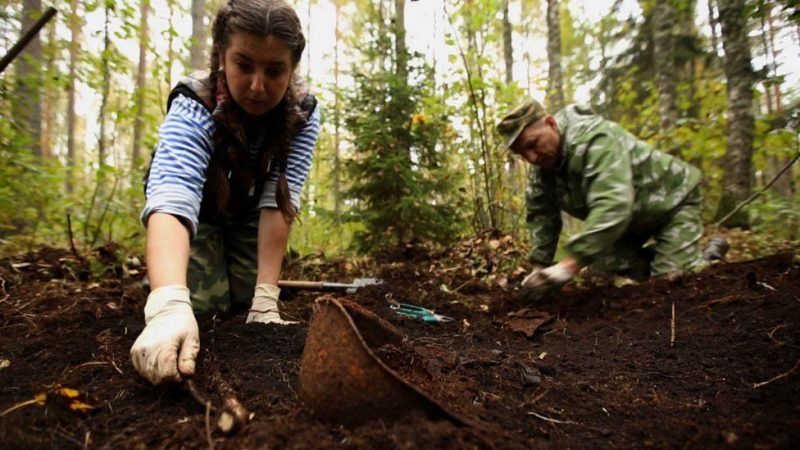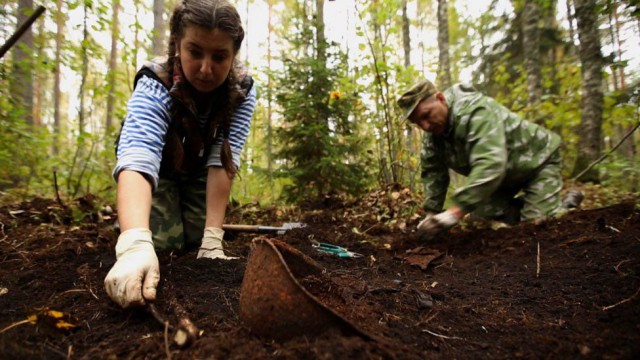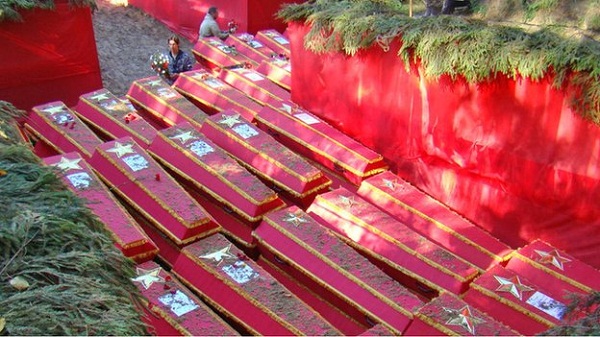Russia’s volunteer body hunters — individuals who are willing to devout their time and effort to scouring previous WWII battlefields to look for the remains of missing soldiers; their act aimed to giving them a proper burial and a name.
Russia was one, if not the country with the most casualties during WWII. Of the supposed 70 million deaths it suffered during the war, 26 million were killed on the Eastern Front and over 4 million of that number are treated as missing in action. These unknown soldiers are what these volunteer body hunters are looking for.
The Volunteers
Olga Ivshina is one of those who signed up for this task. She employs the help of her metal detector as she scans the forest, walking slowly, carefully and thoroughly under the pine trees; only the sound her instrument makes breaks the silence of the surroundings.
“They are not buried very deep,” she comments then adds…
“Sometimes we find them just beneath the moss and a few layers of fallen leaves. They are still lying where they fell. The soldiers are waiting for us – waiting for the chance to finally go home.”
In an area nearby, Marina Koutchinskaya bends on her knees and searches through the mud. She has spent most of her holidays being a volunteer body hunter far away from her home, business and her young son for the past 12 years.
“Every spring, summer and autumn I get this strange sort of yearning inside me to go and look for the soldiers. My heart pulls me to do this work,” she says.
Marina and Olga are just two of the many volunteers of the Exploration group who journeyed 12 hours via an army truck just to get to the forest located near St. Petersburg. They live off on primal conditions for their task – wading in waist-deep mud at times – just so they could find the bodies of those who have fallen decades ago during WWII.
Being a volunteer body hunter has its dangers, too. Fallen soldiers have oftentimes been found with grenades still in their backpacks and there are also artillery shells sticking out of the trees. Reportedly, there have been other diggers from different groups who have lost their lives while in volunteering mission elsewhere in Russia.
Meanwhile, Marina found something and held it up – it looked like a box of soap, only it was not, it was TNT.
“Near a naked flame it’s still dangerous, even though it has been lying in the ground for 70 years,” she pointed out.

Soviet and WWII
A lot of countries had been scarred because of WWII but no other suffered loss as much as the Soviet Union did.
June 22, 1941 – the day when Hitler launched his Operation Barbarossa, the biggest and bloodiest drive throughout military history which aimed at adding huge areas of USSR to Germany’s Third Reich. St. Petersburg, known that time as Leningrad, was one of the said campaign’s main targets. In just less than three months, the coming German troops were able to encircle the whole city while starting to attack it through air.
However, the attempts to get the city by storm proved unsuccessful so Hitler opted for another tactic – starving it. But the Red Army fought hard, desperately over the next two years just so they could cut through the Germans’ line.
Olga and Marina are working in an area near the town of Lyuban which is just 80 kilometers away from St. Petersburg going south. In this location, measuring just a mere 10 square kilometers, about 19,000 soldiers were killed in a span of days in 1942. As of recent times, diggers have uncovered 2,000 remains.
The most experienced member of the Exploration team, Ilya Prokoviev, carfully pokes the ground with the use of a long spike made of metal. Ilya, a former army officer, found his first soldier in a walk through the countryside 3 decades ago.
“I was crossing a swamp when suddenly I saw some boots sticking out of the mud,” he recounts. “A bit further away, I found a Soviet helmet. Then I scraped away some moss and saw a soldier. I was shocked. It was 1983, I was 40km from Leningrad and there lay the remains of a soldier who hadn’t been buried. After that there were more and more and more, and we realized these bodies were to be found everywhere – and on a massive scale.”
The Soldiers’ Sorry Plight
According to Valery Kudinsky, the defense military official tasked with the war graves, there was no time to bury the fallen soldiers while at the heat of the battle.
“In just three months the German death machine covered more than 2,000km (1,250 miles) of our land. So many Red Army units were killed, wiped out or surrounded – how could anyone think about burials, let alone records of burials, in such conditions?” Kudinsky pointed out.
He then added that Russia focused on rebuilding the war-torn country immediately after WWII ended. However, that explanation is not enough as to why the battlefields were not cleared and the dead no identified and given at least proper burials.
The diggers hold a different belief – for them, some of the country’s WWII battle fronts were purposely hidden.
“The governing council of the USSR issued decrees in 1963 about destroying any traces of war. If you take a map showing where battles took place, then see where all the new forest plantations and building projects were located, you’ll find they coincide with the front line. Nobody will convince me they planted trees for ecological reasons,” Ilya announces.
If one crouches down in the woods near Lyuban, streaks of trenches can be made out clearly in the earth.
“They actively planted new trees on the battlefield – they ploughed furrows and put the trees exactly in the places where the unburied soldiers were lying,” Marina states.
Recently, she was able to unearth a helmet and in order for them to find its wearer, the team had to pull out two trees nearby.
“When we cleaned away some clumps of earth from the roots we saw two hands tangled up in them. Then we found a pelvis and some ribs between the roots. So we think the whole soldier was underneath the roots and the trees were growing on top of him,” Marina claims.
The question is, how could the workers go through and plough through a land with a tractor when they could visibly see it littered with the bodies of the dead, unburied soldiers?
As Ilya puts it, workers at that time were afraid of going jobless if they refused to do the task at hand. At that time, individuals who didn’t have jobs in Soviet Union were non-persons living as if they didn’t exist; nobody wanted to be like that, thus, they were forced to go through with the job.
Additionally, it was just two decades after WWII. The workers had went through far worse horrors than ploughing through lands with human remains strewn about.
The After effects
The diggers are exposed to horrors, too, as they seek to discover the remains and names of these WWII fallen soldiers.
Nevskaya Dubrovka, located on the banks of the River Neva, had been the setting of one of the bloodiest chapters of the Leningrad campaign. The Red Army fought with every available resources they had just so they could secure a narrow stretch on the riverbank in a bid to break the Germans’ blockade. Countless of the Russian troops, used as mere cannon fodders, were killed within the area.
last summer, the diggers were able to dig out a mass grave. The grave appeared to be hastily prepared by the Russian soldiers, villagers or even the German troops in a move to prevent an epidemic from occurring with the dead just thrown in unceremoniously.
“There must have been 30 or 40 soldiers in there. Four layers of people one on top of the other,” Olga recalls as she sits by the campfire.
“But the skeletons were all mixed up and smashed. Here you have a head – there a leg…” She pauses and gazes at the fire. “Once you’ve seen that, you’ll never forget it. You are no longer the same person you were before.”
Olga works for the BBC Russian Service and after a few weeks spent in the forest as a digger, she finds her city and work life a little hard. She feels estranged whenever her Moscow friends talk about not having enough to buy a new car or a set of designer clothes. She even says that there are times she feels her job as a journalist is pointless, a different feeling she gets from when she is in the forest digging bodies out where she feels she is doing a very important task.
“Sometimes you need to know that you are doing something which is important, that you are not just a piece of dust in this universe. This work connects us to our past. It’s like an anchor which helps us to stay in place even during a storm,” she states.
She views her volunteering as a digger a moral compass at times.
The Second Mission
Finding the dead is not the sole mission of the diggers. They do not stop on that. They try to rid these unknown soldiers their anonymity.
An eternal flame may burn at the Tomb of the Unknown Soldier in Moscow but for these volunteers, the best means to honor those who have fallen during WWII is to give them back their identities.
“The soldier had a family, he had children, he fell in love. Being unknown is nothing to be proud of. We are the ones who made him unknown,” declares Ilya.
But this second mission is not that easy especially since as much as seventy years have passed since the war.
As what the leader of the Exploration group, Alexander Konoplov,puts in:
“The more data we can collect from the spot, the better the chance we have to identify a soldier.”
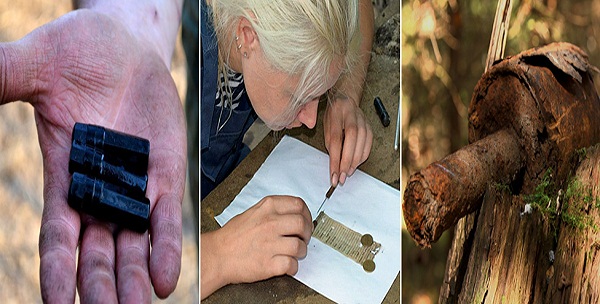
There are times they find old coins with the soldiers’ remains given by their families. The standing belief about this tradition was that if the family loaned him a few coins, he certainly would come home to repay the money.
However, these personal items, though they help build up the person’s picture, are not much of a help when it comes to discovering the bearer’s identity as they do not help in finding out the soldier’s name or place of origin. The most essential key in this is the ID tag.
In WWII, soldiers of the Soviet Union had no metal ID tags. Instead, theirs were made of small ebony capsules with an equally small piece of paper inside containing their personal details. A sad fact,though, is that most of the time, writings in these papers are illegible. Some were also left blank since soldiers had this superstitious belief that filling them would somehow lead to certain death.
Alexander, who was business owner before he devoted his whole time being a digger, found a bullet case stopped up with a small piece of wood which he hoped was an improvised ID tag. But when he turned it upside down in his hand, a trickle of brown liquid came out instead of a roll of paper leaving him a little disappointed.
“Sometimes we find messages with the soldier’s name. Some wrote, ‘If I am killed, please pass this on to my girlfriend or my mum.’ You can’t help feeling touched by it,” Alexander adds.
Exploration and Russia’s Other Digger Groups
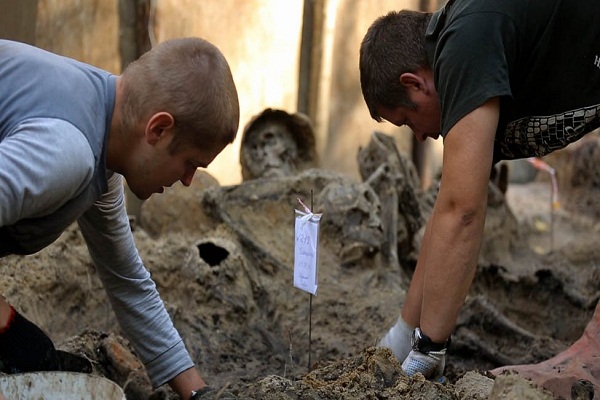
The Exploration group is just one of the 600 groups of diggers at work all throughout Russia who were able to discover a total of 500,000 remains of WWII soldiers at present.
These teams, who look for the soldiers’ bones, are called “white diggers” differentiating them from the black diggers” – those who dig through and search for metals, guns, coins and even gold teeth which they then sell to specialist dealers or online but leave the bones on the ground.
Alexander lets his team follows through a strict set of protocol when it comes to every discovered remains – how they must be excavated, labelled and stored. Each dug up soldier is photographed as well as their location recorded and the information entered into a digital database.
If the years-old ID tag is not decipherable on site, it is packed carefully and is sent to the team’s headquarters located in the Volga city of Kazan.
Here, the team’s technician, Rafik Salakhiev, employs digital imaging and ultraviolet light to bring faded pencil marks to light. When a name does come out, the diggers then pore over old army lists, classified documents and military as well as police contacts to discover the soldier’s identity correctly and locate his surviving family members.
“Every new search gets to me as if it was the first one,” says Rafik.
As most of these relatives are old and not in the very best of health conditions, the group tries to prepare them and break the news gently to them though they have been waiting for this break from their loved one for a long time.
Tracing a soldier’s family can also take years, even decades, to do especially if the said family has moved elsewhere after WWII.
It was in 1942 when people of First Lieutenant Kustov’s home village got hold of the news that he went missing and suspected that he went AWOL and instead worked as a collaborator for the Germans. Because of these suspicions, his young son and daughter were branded as children of a traitor and his family was forced to leave the said village.
When Ilya Prokoviev found Kustov’s body and was able to identify it, it took him months to track his family down and inform them of the discovery.
“When we told them that we had found their father’s remains, for them the feeling was just indescribable. They knew that he hadn’t just deserted, that he couldn’t have behaved like that, but there was never any proof until 60 years later,” he recounted.
Based on the information they gathered from the archives, the diggers found out Kustov was one of Stalin’s commanders tasked in leading his well-known shtrafbats, a unit made up of deserters and prisoners. To be appointed to such post, one needed to be a staunch communist and one of the few officers Stalin trusted.
Kustov’s children took his remains and buried it next to their mother’s grave who had spent her lifetime waiting for his return.
“They had managed to restore historical truth and honour their father’s memory. It was the main event of their lives, I think,” Ilya commented.
Burying the Now Known Remains
Near River Neva’s banks and close to the mass grave the diggers found, a Russian Orthodox priest says prayers while walking around the bright red coffins placed on the grass as the relatives -children, grandchildren and even great-grandchildren of the identified soldiers the diggers have unearthed – watched, some openly shedding their tears.
One of these is Valentina Aliyeva who came to bury the father she had not seen since she was four years old. Throughout the seven decades that passed, the only connection she had with with the lost dad she longed for was a black-and-white photograph of their old family home.
According to her, her mother had remarried a few years after her father was declared “missing in action” and everyone insisted she call her stepfather daddy but she refused as she had an inkling who her real daddy was.
“What those diggers have achieved means so much to me. I can’t tell you how grateful I am,” she emotionally says as her eyes fill with tears.
Among the crowd of relatives, also, were Tatiana Uzarevich and Lyudmila Marinkina, twin sisters in their 50s who have traveled for nine hours via plane from the remote area of Kamchatka into the site to pay their last respects to their grandfather.
He was one of the soldiers buried in the mass grave as the diggers found his ID tag in the location. Unable to trace his family, the group had issued an appeal which aired on the evening news.
Tatiana and Lyudmila’s elderly mother was shocked when she heard his name, Alexander Golik, being announced; the family had been left desolate because of his disappearance. As Lyudmila supplies, because her grandfather was “missing in action”, her grandmother did not hold the right to any financial support given to other relatives of soldiers who served in the Great patriotic War. With four children to raise, times went tough for the widowed woman.
“My mum was so hungry all the time, she begged the other kids for pieces of bread at school,” she adds.
“She only remembers the shape of her fathers’ hands – but she had memories of a kind, good man,” Tatiana also comments. “We just had to come to this reburial service to visit the place where he died and accompany him to his final resting place.”
Red cloth was draped over the walls of the freshly-dug grave – a respectful gesture that in normal circumstances was only granted to army generals. Lined young men dressed in Soviet-styled army uniforms acted as the guard of honor for the event. They are visibly moved, some even looking up the sky, as each red coffin is carried past them to be buried.
There are over 100 coffins with each containing the bones of 12 to 15 men in that reburial ceremony that day. As much as the diggers would have wanted for each soldier to have his own coffin, the extra 1,500 they would have needed for that day’s service kept them back – they simply do not have the means to provide that.
The ceremony acted as the culmination of the diggers’ months of hard work. They successfully brought a sense of semblance of order into a picture of moral chaos in Russia’s history and were able to pay homage to those who lost their lives to WWII.
The stop, however, is temporary. Come spring, they will resume their digging in the fields and forests where countless people were killed. They are persistent to continue until every fallen man has been found though that could take a lifetime of work.
“There are so many unburied soldiers, it will take decades to find them. There will definitely be work for our grandchildren,” says Marina. “But nature is working against us. The remains are decomposing and it is getting harder to find the bones, ID tags and army kit.”
Ilya adds up that the digging has become embedded in their souls, that they need to continue doing it to find peace for themselves – it has become the “meaning of their lives”.
